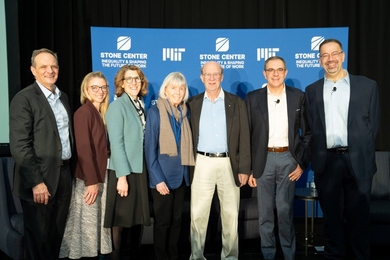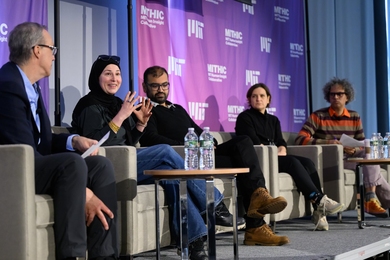Transcript of MIT President Susan Hockfield's opening remarks, titled "MIT and the Challenge of Energy," delivered May 3, 2006, at the MIT Energy Forum.
I am pleased to welcome you to the MIT Energy Forum. This is an important day for MIT. Today, in the culmination of a year's work, the Energy Research Council will outline how MIT can offer leadership on one of the most urgent challenges of our time: finding clean, affordable energy to power up the developed and the developing world.
Of course, many of MIT's faculty and students are already at work on energy issues and producing significant breakthroughs. However, these discrete breakthroughs will have far more impact as parts of a coherent answer to the world's energy problems--an answer where great science and engineering are informed by profound expertise in economics, architecture and urban planning, information technology, political science and management.
That is why we established the Energy Research Council last year, and asked it to design an initiative to facilitate collaboration on this crucial issue across all of the Institute's five schools. I want to thank everyone who contributed to this effort, particularly Professors Robert C. Armstrong and Ernest J. Moniz, who served as co-chairs, and their 14 colleagues on the council. The council solicited advice and input from the entire MIT community and from external stakeholders and listened attentively. Its recommendations reflect deep knowledge and broad vision.
Professor Moniz will talk about the energy initiative itself in just a moment. My role this morning is to take a step back and tell you why I believe this is a defining moment in the history of MIT. I would like to answer the three most basic questions about this call to action: Why energy? Why MIT? And why now?
A great challenge
The short answer to the question "Why energy?" is "popular demand." Early in my tenure here, I asked faculty members and students to identify MIT's opportunities and responsibilities for the decades ahead. The issue they raised most frequently--by a very wide margin--was energy, and they spoke about it passionately. Frankly, when a community of people as brilliant and diverse as those at MIT converges on one issue, it would be folly not to heed them.
However, just as significant as the interest in energy here at MIT is the interest in the world beyond MIT. For the first time in a generation, the public and our political leaders have both turned their attention to the subject. Energy lies at the heart of the news of the day:
Just last week, President Bush again spoke of America's "addiction to oil" and its negative implications for our national security.
Few of us can read about Brazil's new energy independence, thanks to ethanol made from sugar cane, without a sense of envy.
Many Americans are shocked by gasoline at $3 a gallon.
We marvel at the success of Toyota and its hybrid cars and, once again, fear for Detroit's future.
Business leaders--and all of us--worry that the energy needs of China's exploding economy will impinge on our own prosperity.
And finally, the consequences of carbon-fueled climate change are of concern not just to MIT scientists like Professor Kerry Emanuel but also to residents who return to the Gulf Coast worried about a future of increasing "weather intensity."
This may be one of those rare moments when our society suddenly looks itself in the mirror and admits the truth: Our comfortable lives are due in large measure to cheap and abundant fossil fuels, yet we know that we will pay a steep price if our utilization of those fuels does not change.
As a nation, however, we have made so little progress on energy in recent decades that many Americans are simply fatalistic about the issue. The political promises made in the wake of the oil crises of the 1970s prompted very little enduring action. As a business, energy tends to be enormously capital-intensive, which slows the pace of change to a generational crawl. In fact, in the last few decades we have seen more transformative advances in the way we consume music than in the way we consume energy.
Of course, energy is not a single challenge that can be answered with a piece of technology as clean, appealing and profitable as an iPod. It is three intertwined challenges, each vexing and complex in its own right.
The first involves supply and demand. In a business-as-usual future, energy use worldwide is likely to double by mid-century, driven in part by the enormous appetite of the developing economies. China alone has been increasing its energy use by about 10 percent a year, with profound impacts on energy markets. Competition for scarce energy resources is increasingly global, and we Americans can no longer assume the ready availability of cheap fossil fuels far into the future. The world as a whole needs to develop new sources of energy and to increase dramatically the efficiency with which they are used.
This leads to the second challenge: security. Obviously, we all understand the risks that accompany too great a dependence on foreign energy, particularly from politically unstable parts of the world. We also need to secure extended energy delivery systems, which are vulnerable to disruption, whether from sabotage or natural disasters. We must remember that major wars have been fought over access to scarce resources, and our dependence on oil for transport means growing prospects for conflict over energy supply. And while there is a renewed interest in nuclear power as an alternative to carbon-based fuels, we must answer the questions about the consequent potential for the proliferation of nuclear weapons.
The third challenge is the environment. How will we meet our increasing demand for energy without smothering the earth in greenhouse gases? After all, the internal combustion engine is a brilliant piece of technology. Until the price of gasoline rises so high as to make alternatives to it economical, it is here to stay. We have to look at improving efficiency in our continuing use of fossil fuels--and possibly mitigating their impact with large-scale carbon sequestration. At the same time, we clearly have to expand dramatically our use of technologies that are less carbon-intensive, or are carbon-free.
As a problem, energy is hydra-headed. Concentrating on one set of fangs while ignoring the others is hardly a strategy for self-preservation. Yet the public debate on energy has largely focused on patchwork solutions, such as how to lower the cost of gasoline at the pump in the short term. At MIT, starting today, we intend to redirect this debate toward the entire energy system. It is time to consider measures that will improve the world's energy infrastructure and mix. It is time to support the basic research that will transform this infrastructure in the long-term. And it is time to make sure that this infrastructure will suit a rapidly evolving world, so that economic growth worldwide can help solve our energy problems rather than exacerbate them.
A role for MIT
This leads me to my second question: Why MIT? Why are we the right people to lead this charge?
Obviously, no single institution alone is going to transform the energy landscape. But the unique character of MIT offers something important to the equation. We believe we can be a catalyst for a technological phase shift.
We have the expertise in science, technology, public policy, economics, urban design and management to produce transformational advances. We also have a history of solving problems across disciplines. Our forebears wove a practical mindset into the fabric of this institution, an engineering determination to "fix it." We were established as a land-grant university with an activist mission to promote the public good.
We have long since proven that when we focus on large issues of great public importance, we are able to get things done. The Radiation Laboratory here at MIT played a decisive role in the Allied victory in World War II, designing over 100 radar systems used in the war, and also established a successful model for "connected science" -- a collaboration between scientists, industry and government that continues today at MIT. In the process, the Rad Lab laid the foundations for modern electronics. This is exactly the connected model that will help us address the challenges posed by energy.
MIT is also the place where many of the most important technologists of tomorrow will be educated; by expanding our energy curriculum, we can steer them toward this challenge.
Clearly, given the appetite for energy in developing economies like China and India, the international nature of fuel production, and estimates that electricity has yet to reach billions of people worldwide, it is going to take a global perspective to solve the world's energy problems. This, too, is an area where MIT has expertise. Ten years go, MIT joined forces with universities in Japan, Sweden and Switzerland to create the Alliance for Global Sustainability, a joint research program focused on environmentally sound development worldwide. Last year, MIT partnered with the Kuwait Foundation for the Advancement of Sciences to found a new center to study the environmental, hydrologic and management issues surrounding the crucial resources of petroleum and water.
As a community, we are also in a unique position to push forward market-based reforms in energy--not just because of our close collaborations with industry, but also because of our history of innovation and entrepreneurship. A study a decade ago estimated that if you added up the revenues of the companies started by MIT graduates and faculty, together they would represent the 24th-largest economy in the world. If you added in the gain from technologies and innovations in whose development the MIT family played a significant role, it would be far larger.
While we expect to work closely with industry and government on this energy initiative, let us not forget how important universities are to progress of all kinds. Our diverse talents and our position outside of political and commercial constraints means we can try things, and say things, that the other big players in this game may not be able to. We hope to be viewed as an honest broker of energy solutions.
A time for action
And so we arrive at my last question: Why now?
I mentioned earlier that public and political willingness to address this problem is as great as it has been in a generation. Climbing oil prices, as painful as they may be in the short term, are making the marketplace more receptive to transformative technologies than it has ever been in the past. The entrepreneurial and venture capital engines created to advance the information technology and biotechnology revolutions are starting to look seriously at energy.
However, the news outside of MIT is not the only reason that the moment is ripe for MIT to lead an energy charge. There is also the tremendous hope that is being generated within MIT by our own promising research:
Nanoscience breakthroughs by MIT scientists may overcome the major technological impediment to electric cars: the weight, cost and weak performance of today's batteries.
Advances in photovoltaics being developed here could make solar power a more practical option.
Bioengineering research here at MIT may help us create better biofuels as a substitute for petroleum.
And, improvements in the technology of nuclear power plants could help us reduce CO2 emissions on a large scale.
These are but a few among many examples of critical breakthroughs on the horizon at MIT. I firmly believe that university research and teaching can transform our use of energy just as they have transformed our use of information. The results will be not just a cleaner and safer world, but also a more prosperous world. Professor Robert Solow, one of MIT's Nobel laureates in economics, has estimated that more than half of America's economic growth over the last 60 years derives directly from technological innovation. Too often energy transformation has been viewed as carrying a heavy societal cost. In fact, it has the potential for great social and economic gain.
It is time for the field of energy to experience a flowering of creativity that it has not seen in decades. There are tremendous opportunities here for those who take on the challenges. At MIT, we intend to provide the leadership this critical issue demands.






